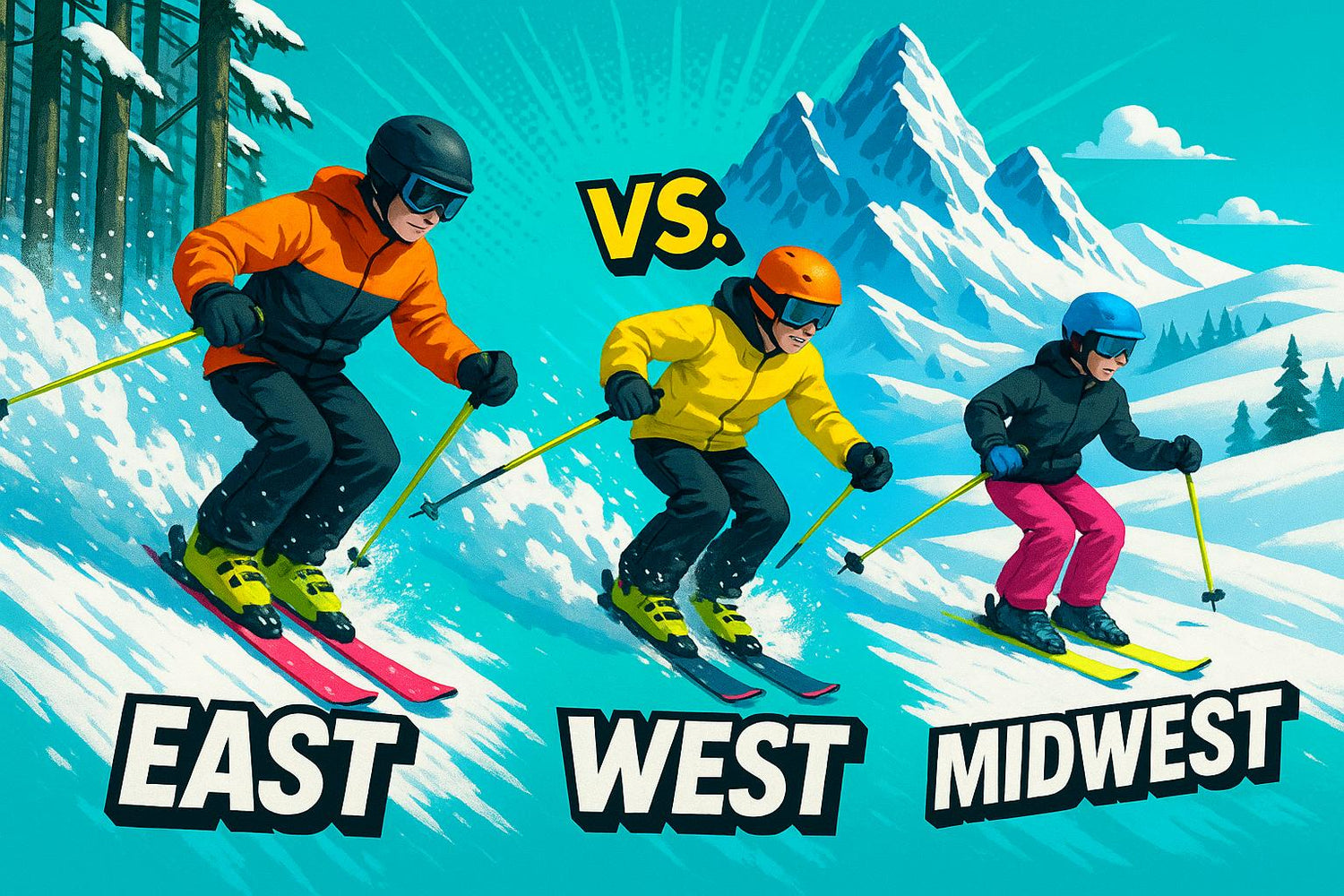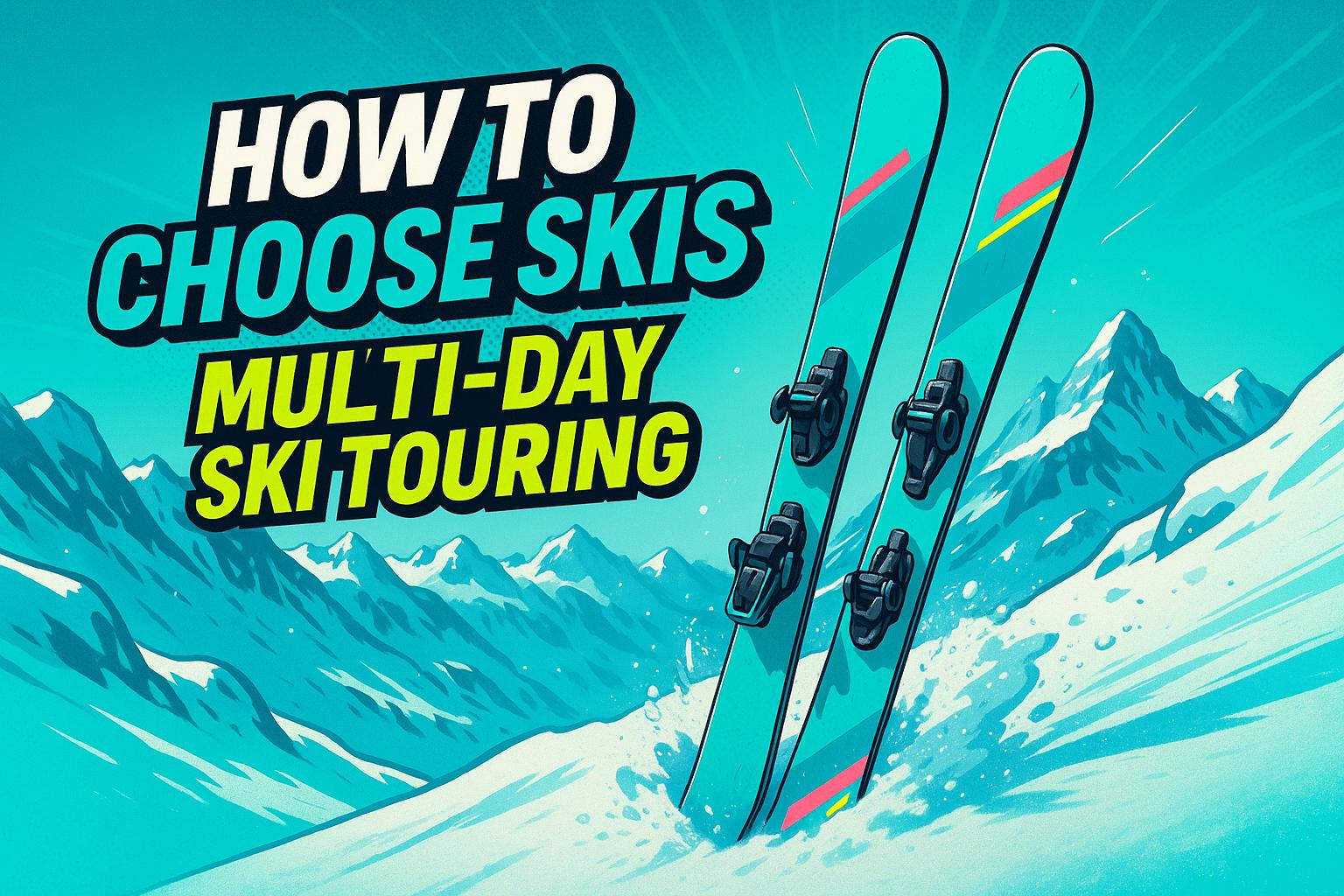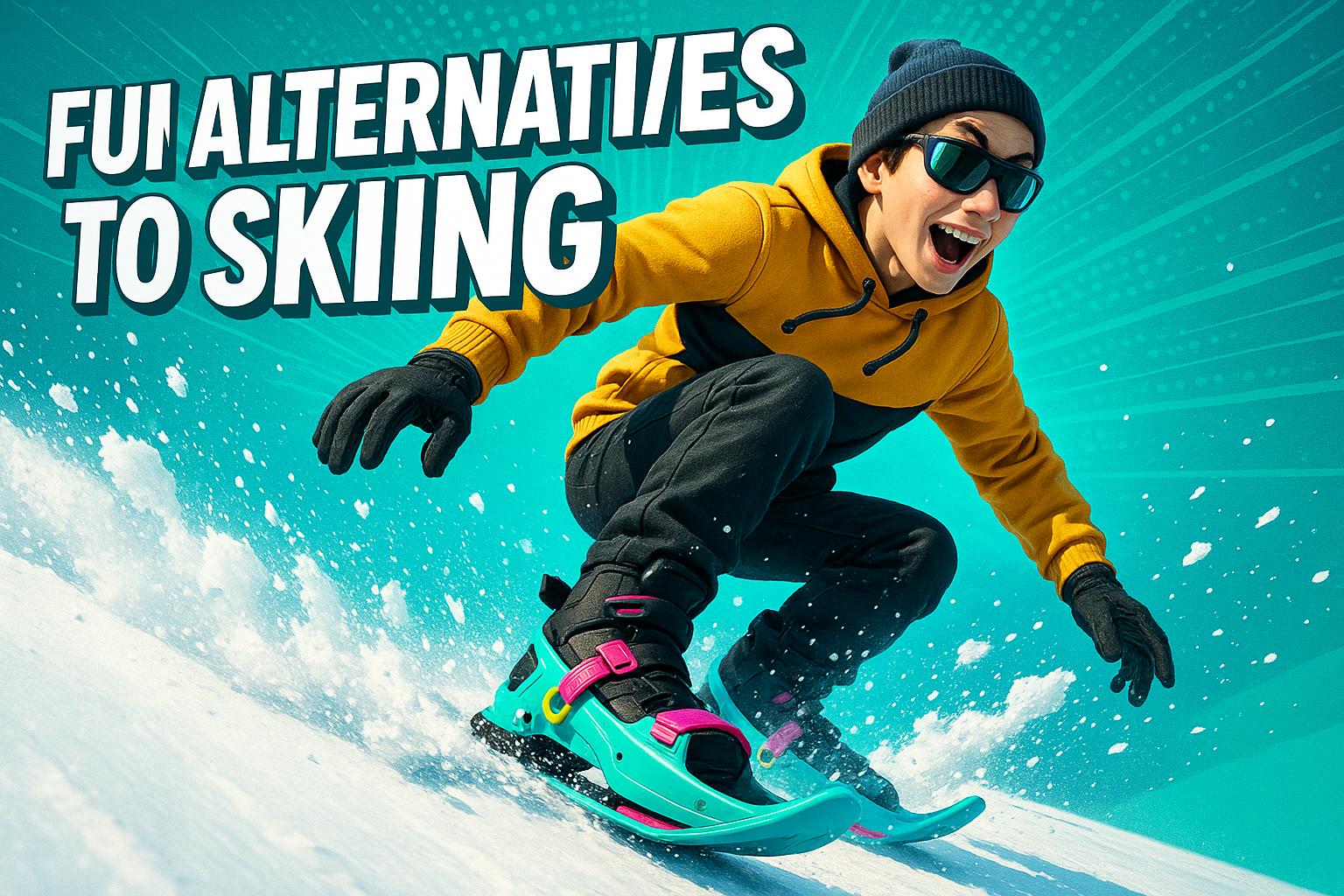Choosing the right ski gear depends on where you’re skiing: icy East Coast slopes, powder-filled West Coast mountains, or the groomed trails of the Midwest. Each region has unique terrain and snow conditions, so your equipment should match the challenges you'll face.
- East Coast: Known for icy, narrow trails and unpredictable weather. Opt for narrow carving skis or compact gear like Snowfeet Skiblades (65 cm) for better control on hard-packed snow.
- West Coast: Famous for fluffy powder and wide-open bowls. Wider skis (90–105 mm waist) or Snowfeet POWDER (99 cm) provide the float needed for deep snow.
- Midwest: Gentle slopes and shorter runs dominate. Compact, portable gear like Snowfeet Mini Ski Skates (38 cm) ensures precision and ease on well-groomed trails.
Quick Comparison
| Region | Terrain Features | Snow Conditions | Best Gear Options |
|---|---|---|---|
| East Coast | Narrow, icy trails; tree-lined runs | Icy mornings, slushy afternoons | Snowfeet Skiblades (65 cm) - $450 |
| West Coast | Wide bowls, steep vertical drops | Deep powder, consistent snow | Snowfeet POWDER (99 cm) - $490 |
| Midwest | Groomed trails, gentle slopes | Freeze-thaw cycles, manmade snow | Snowfeet Mini Ski Skates (38 cm) - $150 |
Snowfeet gear stands out for its portability and versatility, making it easier to handle diverse conditions without needing multiple pairs of skis. Whether tackling Vermont’s icy slopes, Utah’s powder, or Michigan’s groomers, Snowfeet products simplify your ski adventures.
1. East Coast Ski Terrain
Terrain Characteristics
Skiing on the East Coast comes with its own flavor of adventure. The trails here are known for their winding, tree-lined paths that require precision and quick thinking. Unlike the wide-open bowls you’ll find out West in places like Colorado or Utah, East Coast runs are more compact and intimate. Most mountains stay below the treeline, creating a unique skiing experience often referred to as a "wooded terrain culture".
As Hans Riemer, a skier with over six decades of experience across North America and Europe, puts it:
"I can say that if you can ski the East, you can ski anywhere."
Take trails like Stowe’s Front Four, for example - they’re a true test of skill for even the most seasoned skiers. With narrow runs, dense tree coverage, and constantly changing conditions, the East demands agility and control. It’s a playground for those who enjoy a challenge, offering a mix of terrain that keeps you on your toes.
Snow Conditions
There’s a reason the East Coast has earned the nickname "Ice Coast". The region’s weather patterns, with frequent freeze-thaw cycles and occasional rain, often result in firm, icy surfaces. Skiing here can sometimes feel more like skating. Frank MacConnel, owner of Bob Skinner’s Ski & Sport, explains:
"Because we're so close to the ocean, the water molecule in the snow is a little larger... Also, the water is soft, not hard. These things make a huge difference with the density of the snow."
To combat these tricky conditions, Eastern resorts rely heavily on snowmaking and grooming. For instance, Windham Mountain in New York has snowmaking systems that cover an impressive 97% of its terrain. Unlike the powdery slopes of the West, the East often transitions from icy, rock-hard surfaces in the morning to slushy, wet snow by the afternoon. Greg Klein from Willi’s Ski Shop adds that skiing on such surfaces, especially on injected hills with boilerplate conditions, requires careful attention to reducing strain on your knees.
Equipment Suitability
When it comes to tackling the East Coast’s icy slopes and tight trails, the right gear can make all the difference. Traditional skis in the 75–85 mm range are often preferred for their ability to grip and carve on hard-packed snow. But there’s also a growing interest in compact equipment like Snowfeet* products, which are perfectly suited for these conditions.
Snowfeet* Skiblades and Skiskates are gaining popularity for their compact design and ease of control. The Snowfeet team highlights their advantages:
"One of the best things about snowblades is how easy they are to control. Because they're shorter, there's less ski to manage, making them perfect if you seek easier control."
This level of control is especially handy on crowded slopes or when navigating tight, tree-lined runs. Their small size allows for quick, tight turns - ideal for dodging other skiers or threading through narrow spots:
"Snowblades are all about making quick, tight turns. Their small size makes them super easy to maneuver, which is awesome if you're dodging people on crowded runs or threading through tight spots."
Snowfeet* Skiblades, available in lengths from 65 cm to 99 cm, also help reduce knee strain while maintaining enough edge contact for carving on hard snow. Whether you’re dealing with icy mornings or slushy afternoons, their design ensures you can handle whatever the day throws at you. For skiers who love the East Coast’s mix of challenges, this kind of maneuverability is a game-changer.
2. West Coast Ski Terrain
Terrain Characteristics
Skiing on the West Coast is a whole different ball game compared to the East. Out here, the mountains are massive, offering way more skiable terrain. Take Powder Mountain in Utah, for example - it has over 8,000 acres of skiable space, which completely overshadows most Eastern resorts.
The trails in the West are longer, wider, and steeper. Instead of weaving through tight, tree-lined runs like you’d find back East, you’re met with sprawling bowls and wide-open spaces. Some resorts even take it up a notch with areas accessible by hiking or snowcat, plus backcountry gates for seasoned skiers looking for untouched powder.
Thanks to the higher elevations - like Silverton Mountain at a jaw-dropping 13,487 feet - the season lasts longer, and the snow conditions stay more consistent. Plus, those high-altitude views? Absolutely unforgettable.
Snow Conditions
When it comes to snow, the West has a serious edge. With low humidity, cooler temperatures, and loads of natural snowfall, the conditions are ideal for skiing. This is where you’ll find the legendary powder snow that skiers dream of. Resorts like Alta and Snowbird in Utah get over 500 inches of snow every year - that’s more than 40 feet of the fluffy stuff! Compare that to the East Coast, which leans heavily on snowmaking, and it’s easy to see why Western skiing has such a loyal fan base.
That said, even the best Western resorts can get crowded during peak times.
Equipment Suitability
The varied terrain of the West calls for gear that can handle everything from groomed runs to deep powder bowls. All-mountain skis with waist widths between 90mm and 105mm are a go-to for many skiers in the Rockies and along the West Coast. But there’s also growing interest in lightweight, portable gear that’s easier to transport.
This is where Snowfeet* products shine. The Snowfeet* POWDER skiboards (99 cm) are built for deep snow, offering the float you need in powder while staying highly maneuverable. For those who like to mix it up, Snowfeet* Skiblades, ranging from 65–99 cm, are a solid choice. They’re nimble on groomed runs and perform well in powder, making them perfect for resort-hopping adventures.
And here’s the kicker: Snowfeet* gear is super portable. Unlike traditional skis that need roof racks or careful packing, Snowfeet* products fit easily in your car - or even in your luggage if you’re flying. This makes them a game-changer for those looking to explore multiple resorts without the hassle of bulky equipment.
3. Midwest Ski Terrain
Terrain Characteristics
Skiing in the Midwest comes with its own charm. Instead of towering mountain peaks, you'll find gentle hills and shorter runs - perfect for families and beginners. Many resorts in the region focus on creating a welcoming atmosphere with well-maintained groomed trails and terrain parks to keep things fun and accessible.
Snow Conditions
When it comes to snow, the Midwest is all about adaptability. The region sees an average of 273 inches of snowfall each year, much of it thanks to lake-effect snow. But with frequent freeze-thaw cycles, conditions can swing from fresh powder to icy hardpack in no time. This makes snow management a top priority for resorts, which rely heavily on advanced snowmaking systems to keep the slopes in good shape throughout the season. These ever-changing conditions mean skiers need gear that can handle a little bit of everything.
Equipment Suitability
The Midwest’s compact slopes call for gear that’s nimble and easy to handle. Traditional long skis, like those from Rossignol or Atomic, can feel awkward on the region’s shorter, tighter runs. That’s where Snowfeet* products come into play. Their compact design is a game-changer for Midwest skiing.
- The Snowfeet Mini Ski Skates (38 cm)* are priced at $150 and are perfect for beginners looking for a fun, approachable way to hit the slopes.
- For intermediate skiers, the Snowfeet PRO (50 cm)* at $199 offers improved performance and versatility.
- Want to carve up groomed trails or explore terrain parks? The Snowfeet Skiblades (65 cm)* at $450 are a top pick for precision and control.
One happy customer, Vanessa from the UK, shared her enthusiasm:
"Easily one of the best purchases I have ever made to date."
Another major perk of Snowfeet* gear? Portability. Unlike traditional skis that need bulky roof racks, these compact options can easily fit in your car. With over 5,500 glowing reviews and a stellar 4.9/5 rating, it’s clear these products are a hit. Plus, the Snowfeet Skiblades* are even allowed at select resorts when equipped with a safety device, making them a practical choice for the Midwest’s ever-changing snow conditions.
sbb-itb-17ade95
How to Choose Skis: Ski Size, Types of Skis & More
Regional Comparison: Benefits and Drawbacks
Every skiing region has its own vibe, and knowing what to expect can make or break your trip. The East Coast is all about intensity, with icy slopes and unpredictable weather that push your skills to the limit. These conditions demand gear that can handle quick adjustments - exactly where Snowfeet* shines. Plus, Eastern resorts often have shorter lift lines and a cozier, more personal feel compared to the sprawling destinations out west.
On the flip side, the West Coast offers powder days that feel like a dream, towering vertical drops, and stunning alpine bowls that stretch above the treeline. Western resorts usually see more natural snowfall and less ice, thanks to lower humidity levels. But this snowy paradise has its downsides: longer lift lines, higher prices, and packed slopes during peak times. Gear like Snowfeet* is a game-changer here, offering the versatility you need to navigate these world-class terrains.
The Midwest, meanwhile, is the go-to spot for accessibility and family-friendly vibes. With gentle slopes and well-maintained terrain parks, it's a great place to learn and have fun without the stress of intimidating runs. The trade-off? Less vertical terrain and a heavy reliance on snowmaking due to inconsistent natural snow. Here’s a quick breakdown to help match your gear to the region:
| Region | Advantages | Disadvantages | Best Snowfeet* Products |
|---|---|---|---|
| East Coast | Builds skills with challenging conditions; shorter lift lines; cozy resort atmosphere | Icy slopes; fewer powder days; snowmaking reliance | Snowfeet PRO (50 cm) - $199; Skiblades (65 cm) - $450 |
| West Coast | Tons of natural powder; huge vertical drops; above-treeline terrain | Crowded slopes; pricey resorts; long lift lines | Snowfeet POWDER (99 cm) - $490; Short Skis (120 cm) - $690 |
| Midwest | Family-friendly; easy access; great parks | Limited vertical; snowmaking dependence; shorter runs | Mini Ski Skates (38 cm) - $150; Snowfeet PRO (50 cm) - $199 |
What makes Snowfeet* stand out across all regions is their portability and ability to handle diverse conditions. Unlike traditional skis from brands like Rossignol or Atomic, which often excel only in specific settings, Snowfeet* gear is built to adapt. On the East Coast’s icy groomers, their shorter edge length means quick, precise turns that longer skis struggle to pull off. In the West’s deep powder, models like the Snowfeet POWDER (99 cm) give you the float you need without the bulk of traditional powder skis.
Portability is another huge win. Snowfeet* products are compact enough to toss in your car, making spontaneous ski trips a breeze - whether you’re heading to Vermont’s icy slopes or Colorado’s powder-filled bowls.
Pro snowboarder Maggie Leon sums it up well:
"I just think the East Coast scene gets slightly overlooked when there's a lot of really cool shit going on."
Each region has its own unique skiing culture, and Snowfeet* gear lets you experience it all without being tied to region-specific equipment. Whether you're carving through East Coast ice or gliding through West Coast powder, Snowfeet* ensures you're ready for whatever the mountain throws your way.
Conclusion
Every skiing region has its quirks. The East brings icy hardpack and unpredictable conditions, the West boasts deep powder and daring drops, and the Midwest offers groomed, family-friendly slopes. Each demands gear that can handle its unique challenges.
This is where Snowfeet* stands out. Unlike traditional ski brands that push you to buy gear tailored for specific conditions, Snowfeet* products are designed to handle it all. Their shorter design delivers precise control on icy terrain, while models like the Snowfeet POWDER (99 cm) provide the float you need for Western powder - without the bulk of traditional powder skis. Compared to brands like Head or Elan, Snowfeet* offers a truly versatile, all-in-one solution.
Another game-changer? Portability. Snowfeet* gear easily fits in your car trunk, making last-minute trips a breeze - whether you're chasing fresh powder in Utah or heading to a local hill in Michigan. Try doing that with a pair of 180cm skis from Head or Elan!
This ability to perform across different terrains is why so many skiers are turning to Snowfeet*. It’s gear that adapts to the demands of modern skiing, whether you're carving on the East Coast's managed snow or floating through the Rockies' natural powder.
Snowfeet* is redefining what ski gear can do. Forget needing multiple pairs of skis for different trips. With Snowfeet*, you get a smaller, smarter, and more portable solution that’s ready for any adventure. Ready to embrace the future of skiing? Snowfeet* has you covered.
FAQs
How do snow conditions in the East, West, and Midwest impact the ski gear I should use?
Snow conditions across the East, West, and Midwest can vary a lot, and these differences really matter when picking the right ski gear. In the East, where the snow is often icy and hard-packed, narrow skis or gear designed for sharp, precise turns - like those from Rossignol or Atomic - are usually the go-to. But here’s where Snowfeet skiskates shine. Their lightweight, compact design makes them perfect for handling icy terrain with agility, offering more flexibility than traditional skis.
Out West, the story changes. The snow tends to be softer and powdery, which is where wider skis usually come into play to help you glide through the fluff. But guess what? Snowfeet gear works great here, too! They combine the thrill of skiing and skating, all while staying super portable and easy to use. Unlike traditional skis, which can be bulky and a hassle to lug around, Snowfeet gear is perfect for spontaneous adventures and adapting to different snow conditions. Their clever design ensures a fun, no-fuss experience on any terrain, making them a solid option no matter where you ski.
Why are Snowfeet products a better choice than traditional skis for different types of ski terrain?
Snowfeet products offer a refreshing twist on snow sports, combining convenience and performance in a compact package. Unlike traditional skis, which can be bulky and require specialized boots, Snowfeet are lightweight, easy to carry, and work with your regular winter footwear. This makes them a fantastic option for anyone who values portability without compromising on fun. Their shorter design also means you can make quicker turns and enjoy greater control, whether you're cruising on groomed trails, tackling icy patches, or even gliding through powder.
Another big plus? Snowfeet are gentler on your knees. Traditional skis, like those from brands such as Rossignol or Atomic, often put extra strain on your joints during sharp turns. Snowfeet, on the other hand, offer a more joint-friendly alternative. And let’s talk about cost - Snowfeet are a budget-friendly choice, starting at about $150, compared to the hefty $1,200+ price tag of a full ski setup. Whether you’re new to skiing or a seasoned pro looking for something fun and hassle-free, Snowfeet deliver a great mix of value and versatility across all kinds of snow conditions.
Are Snowfeet products good for beginners, or are they better suited for advanced skiers?
Snowfeet gear works great for both first-timers and seasoned skiers. Thanks to their compact and lightweight build, they’re super easy to control, making them ideal for learning the ropes. Beginners will love how forgiving and easy they are to handle, while experienced skiers can take advantage of their flexibility and ability to tackle different types of terrain.
Unlike traditional skis from brands like Rossignol or Atomic, Snowfeet products are especially beginner-friendly. Their shorter length means less strain on your knees and joints, offering a fun and low-impact way to dive into winter sports. Whether you’re hitting the slopes for the first time or you’ve been skiing for years, Snowfeet adjusts to your skill level and makes every ride enjoyable.


































Leave a comment
This site is protected by hCaptcha and the hCaptcha Privacy Policy and Terms of Service apply.